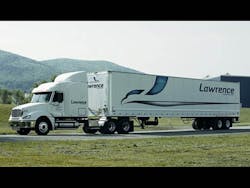Company: Lawrence Companies, Roanoke, VA
Operation: Provides a range of services that include truckload, dry van, flatbed and intermodal, as well as logistics, warehousing, and moving and storage
Problem:
Lawrence Companies, based in Roanoke, VA, began in 1932. Today, the company operates more than 200 power units and 800 trailers, handling about 20,000 loads per year. Like many other fleets in this complex, always changing business, Lawrence Companies decided it was time to leverage technology to help it improve operating efficiency and profitability.
“I came to the transportation industry rather recently,” says Walter A. Grigg, III, vice president of strategic development and business intelligence. “And I was really floored by the complexity of truckload, irregular route operations. Where I had come from, we lived in a world of data and data-driven decisions. There was no other way.
“In trucking, on the other hand, there was/is still a lot of management by gut feeling. And it got the job done,” he observes. “I was hired to look at the information we had available here and how we could leverage that [to improve our operation and our profitability].
“Now inside our company, we have a saying, ‘What got us here won’t get us there’—ahead in the new world,” he notes.
Solution:
“Six months ago, we had nothing other than historical information from our transportation management software,” Grigg recalls. “Data visibility was poor and only provided generalities about what had already happened in our business. With Transportation Costing Group’s (TCG) Truckload Cost Information System, we have a forward-looking solution that accounts for the complexities in a truckload operation and brings to light trends. [It] forces us to be incredibly insightful…It is a game-changing tool that has quickly had a positive effect on our business.
“In lots of ways, we did not know what we would discover,” he says. “The system really opens up truths about the business. We’d look at data and then go back and challenge the logic behind it. Is the data bad? Is the process bad? Where are we getting this data?”
Time-based costing just took off, Grigg says. “There was a real domino effect. For instance, we discovered that dispatchers were not really using the arrivals and departures function in our existing truck management system correctly, so we were not tracking detention time and billing for it properly. Why not?”
It turned out that the dispatchers needed more training on the system, so they got the training they needed, he notes. “Then we went to talk with some of our customers about their detention times. Our costing and pricing system helps us to see where to make changes to make things better,” Grigg says.
“TCG provides us with month-over-month reporting that lets us see what went right and what went wrong. Then we can apply those learned lessons to our day-to-day operations,” he says. “[It] is a very powerful system that gives great insight into our profitability for existing customers as well as new or potential business, and it is helping us make more effective rating, pricing and operational decisions.
“Data tells you what it tells you,” Grigg adds, “but then it is up to you to decide what you are going to do with it. The data provides opportunity and insights, but it is still up to the business leaders to make good business decisions.”
“There is plenty of business out there for everybody now. You just have to make sure you are doing the best for your company,” he concludes.
About the Author
Wendy Leavitt
Wendy Leavitt is a former FleetOwner editor who wrote for the publication from 1998 to 2021.
